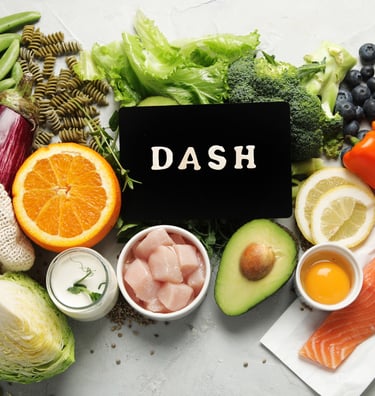Five Most Beneficial Diets: DASH
The last, and fifth diet of my five standout diets is the DASH. This diet stands out for its effective approach to managing hypertension through a balanced and heart-healthy eating pattern.
The DASH Diet stands out for its effective approach to managing hypertension through a balanced and heart-healthy eating pattern.
Pros:
Focuses on reducing sodium intake for heart health.
Emphasises whole foods, including fruits, vegetables, and lean proteins.
Supports overall well-being and helps manage blood pressure.
Why:
The DASH (Dietary Approaches to Stop Hypertension) diet is a dietary plan designed to prevent and manage hypertension, a prevalent health concern globally. This evidence-based approach emphasises the consumption of nutrient-rich foods to lower blood pressure and enhance overall cardiovascular health.
Key Principles of the DASH Diet
Focus on Nutrient-Rich Foods:
The DASH diet prioritises fruits, vegetables, whole grains, lean proteins, and low-fat dairy products. These foods are rich in essential nutrients such as potassium, calcium, and magnesium, which play crucial roles in blood pressure regulation.
Limit Sodium Intake:
Sodium reduction is a cornerstone of the DASH diet. By limiting high-sodium foods, individuals can mitigate the risk of hypertension. The emphasis on whole, unprocessed foods contributes to lower sodium intake.
Balanced Macronutrients:
The diet promotes a balanced intake of macronutrients, including carbohydrates, protein, and healthy fats. This balance supports overall health and helps control blood pressure.
Scientific Backing
Numerous studies highlight the effectiveness of the DASH diet in reducing blood pressure and lowering the risk of cardiovascular diseases. The incorporation of heart-healthy foods contributes to improved cholesterol levels and overall cardiovascular well-being.
Practical Implementation
Meal Planning:
Structuring meals around DASH diet principles involves incorporating a variety of fruits, vegetables, and whole grains while reducing processed and high-sodium foods.
Advantages:
Blood Pressure Management: The DASH Diet is designed to help manage and prevent hypertension, promoting heart health.
Scientific Backing: Numerous studies highlight the wide-ranging health benefits of the DASH Diet, providing a solid foundation for its effectiveness.
Heart-Healthy Focus: With a focus on fruits, vegetables, lean proteins, and whole grains, the DASH Diet encourages heart-healthy eating habits.
Tolerability: Generally well-tolerated, the DASH Diet may feel less restrictive compared to other eating plans, making it easier for individuals to adhere to.
Disadvantages:
Cost: Following the DASH Diet, which emphasises fresh produce and whole grains, can be more expensive than a diet rich in processed foods, potentially impacting budget-conscious individuals.
Weight Loss Specifics: While effective for managing blood pressure, the DASH Diet may not provide explicit guidelines for weight loss, which could be a drawback for those seeking a comprehensive weight management plan.
Potential Cost and Accessibility of Ingredients: Fresh fruits, vegetables, and whole grains, which are staples of the DASH Diet, may be costlier and less accessible for some individuals, potentially limiting its widespread adoption.
The DASH diet serves as a powerful tool for promoting heart health and managing hypertension through a balanced and nutrient-rich approach to nutrition. Its emphasis on whole foods and restriction of sodium align with broader recommendations for cardiovascular well-being, making it a valuable dietary strategy for individuals seeking to enhance their overall health.


